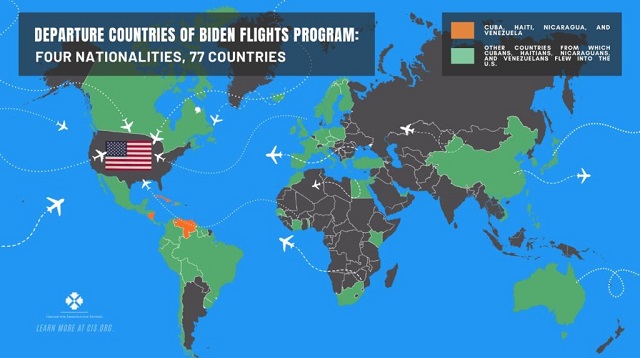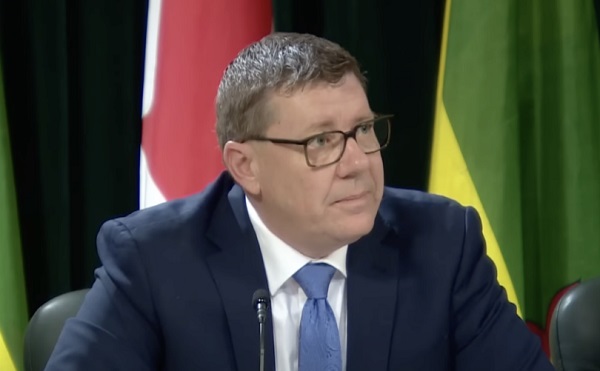Great Reset
Many Migrants in Biden’s ‘Humanitarian’ Flights Scheme Coming in from Safe Countries and Vacation Wonderlands

By Todd Bensman as published June 17, 2024 by the Center for Immigration Studies
In late 2022 and early 2023, President Joe Biden’s Department of Homeland Security launched one of the most unusual humanitarian programs in U.S. immigration history: it unilaterally began authorizing inadmissible Cubans, Haitians, Nicaraguans, and Venezuelans (thus the shorthand name CHNV Program) and their immediate family members to fly commercially from foreign countries into more than 40 American airports.
The administration has used this legally dubious program to authorize more than 460,000 ostensibly endangered nationals of those four countries to fly directly from undisclosed airports abroad into some 45 U.S. airports from October 2022 through May 2024. They are then released on temporary humanitarian parole of renewable two-year periods with work permits, during which time they are assumed (but not required) to be applying for asylum.
From this massive “rescue” program’s inception, the Biden administration has claimed that its purpose was to provide temporary U.S. sanctuary “for urgent humanitarian reasons” for those facing persecution in their native countries, and thus reduce the incentive to pass through Mexico on “dangerous routes that pose serious risks to migrant’s lives and safety” on their way to illegally cross the U.S. border.
But new information that the Center for Immigration Studies has forced from the government through litigation now reveals that, while all participants are nationals of Cuba, Haiti, Nicaragua, or Venezuela, many are flying to the United States from 73 other nations. (See the list of countries provided by DHS here.)
The departure country list casts serious doubt on whether the Biden administration has used the humanitarian rescue flights program as it was sold to the American public. In fact, the new departure country information shows that many migrants from these four nationalities have been heading to the U.S. from some of the safest, most prosperous nations on Earth, some heralded worldwide as vacation wonderlands. They could not have been suffering urgent humanitarian problems there, nor were they anywhere near dangerous migration trails.
Economic Giants and Vacation Hotspots
CHNV nationals are flying to the U.S. from Iceland and from Fiji and from Greece.
They are flying from the wealthy European Union countries of France and Germany, from Finland and Norway, from the Netherlands and Switzerland, and from Sweden and Italy. They are flying from Poland, Hungary, and the Czech Republic. Presumably, many Cubans, Haitians, Nicaraguans, and Venezuelans have reached these countries to settle and work.
The government’s list of 77 departure countries shows that, yes, ostensibly rescue-worthy Cubans, Haitians, Nicaraguans, and Venezuelans are indeed flying in from their own troubled countries to take their U.S. humanitarian protection, as most observers would presume.
But they are also getting authorizations to fly from beautiful Caribbean vacation hotspots like Barbados, the Bahamas, Jamaica, Martinique, St. Lucia. St. Kitts and Nevis, and St. Vincent and the Grenadines.
The publicly stated purposes of the CHNV program, also called the Advanced Travel Authorization (ATA) program, are at odds with the reality that many are departing from models of prosperous stability and safety, whose own residents could never possibly qualify for U.S. humanitarian protection, nor would ask for it.
“I would say this data is evidence that the parole program is not being used to help aliens flee to safety but, rather, as a secondary immigration system that has not been authorized by Congress,” said Elizabeth Jacobs, Director of Regulatory Affairs for the Center for Immigration Studies, who served as Senior Advisor in the Office of the Chief Counsel for U.S. Citizenship and Immigration Services.
“The Biden administration is likely paroling in aliens who are already ‘firmly resettled’ in safe and orderly countries but are nevertheless benefitting under the guise of urgent humanitarian or significant public benefit reasons,” Jacobs said.
Withholding the true purpose of a major government program in this way is a serious disservice to the American public, she added.
“Congress delegated DHS limited authority to use parole only for urgent humanitarian or significant public benefit reasons,” Jacobs said. “Misleading the public on the administration’s use of parole prevents voters from understanding the real impact of the administration’s policies and may prevent voters from holding the administration accountable for their abuse of the nation’s immigration laws.”
Managing Border Disorder or an Unauthorized Admissions Program?
In addition to humanitarian rescues, the government also cited a “significant public benefit” to the United States for its foreign flights program, that inadmissible aliens authorized to fly over the border into the U.S. would be less likely to illegally cross the southern border, thus lessening the chaos there.
But never disclosed until now is that the Biden DHS is also authorizing untold numbers to depart on U.S.-bound flights from many safe countries so far away from the U.S. border and Latin America that beneficiaries would never need to march the dangerous trails and crowd the U.S. border.
Cubans, Nicaraguans, Haitians, and Venezuelans the U.S. government has cleared for departure are flying in from far-flung prosperous, low crime countries nowhere near the migrant trails of Latin America or the southern border, like South Korea, Japan, Taiwan, and Hong Kong.
Some are departing from Israel. Before the war with Hamas.
They are flying from Australia.
And from the oil-rich states of Qatar and the United Arab Emirates.
The government is authorizing some number to fly in from African nations like South Africa, Morocco, and Senegal. Were any of these threatening to add their number to the southern border’s congestion?
Even Vietnam is on the departure country list.
Dispersed Around the World
Immigrants from all four nations apparently have dispersed all over the world seeking work and improved lifestyles. Perhaps things weren’t working out so well in adoptive countries when the Biden administration threw them a lifeline in the flights program. Europe is a good example.
For several years now, thousands of Cubans have flocked to illegally cross the European Union’s external borders, claiming asylum while seeking to work just as they have in the United States. Many have entered the Balkan countries through Serbia or Greece, popular illegal immigration portals of late, seeking eventual resettlement in Spain, Germany, France and elsewhere. While Greece has cracked down somewhat with reported pushbacks of illegal immigrants to Turkey, plenty of Cubans have found long-term residence in other European countries like Italy.
Venezuelans made up about 6 percent of all EU asylum applications in 2023, amounting to about 60,000, mostly in Spain. Unlike the Cubans, Venezuelans can fly to Europe visa-free for tourism and probably need not have crossed borders illegally for their asylum claims. Nicaraguans also have been known to head for Europe in increasing numbers since 2018.
While Cubans, Haitians, Nicaraguans, and Venezuelans are rarely deported from the safety and social welfare systems of Europe, perhaps some of them saw surer economic or family reunification prospects when the Biden DHS launched its flights program and decided on a lifestyle upgrade by coming to the United States.
“This information suggests that these people are firmly resettled and if they need to seek protection, then they can seek it in the countries they’re living in,” said Andrew Arthur, a Center fellow and former immigration judge. “If they are coming from anyplace other than Cuba, Haiti, Nicaragua, and Venezuela, they’re simply trading up from the third country that they’re coming from. This literally has nothing to do with asylum claims or anything else.”
The Government’s Fight for Secrecy
The CBP public affairs office did not respond to the Center’s emailed questions asking for an explanation about the surprising diversity of those rescued from often safe and prosperous departure nations. The cold shoulder is no surprise.
The obvious Grand Canyon between the administration’s public justifications for its humanitarian flights program and what it is really doing might explain why the Biden government has fought hard in court to keep the list of departure nations under wraps.
For more than a year, CBP has refused to comply with a Center for Immigration Studies Freedom of Information Act request to name them. CBP lawyers were so steadfastly opposed to their release that they forced the Center into a long and tedious lawsuit. The effort has finally produced only the names of departure countries but little else the Center requested, such as the specific departure airports and the numbers of people leaving each for American airports.
Government lawyers gave the list of 77 countries but refused during settlement negotiations with the Center to provide even a list in rank order of departure volume. In the end, the agency would only agree to disclose the 77 countries in alphabetical order.
The administration was equally secretive about which U.S. airports were receiving the immigrants, and has never agreed to release them to date, although the Center was eventually able to divine that most were flying into Florida. (See “The Florida Gateway: Data Shows Most Migrant Flights Landing in Gov. DeSantis’s Sunshine State”.) The House Homeland Security Committee, which obtained the airport locations by subpoena, later released the information.
Colin Farnsworth, the Center’s Chief FOIA Counsel, said the litigation is now settled and no more information will be forthcoming. He explained, “Although the government had no legitimate claims for withholding the foreign airports the participants of the ATA program were flying from, and their respective departure volumes, CIS determined it was in the public’s interest to quickly obtain the list of related foreign countries by settling the lawsuit, instead of allowing the government to extensively delay the release of any records through a lengthy legal process.”
Censorship Industrial Complex
How Wikipedia Got Captured: Leftist Editors & Foreign Influence On Internet’s Biggest Source of Info

Fr0m Stossel TV
I once reported how great Wikipedia is. But now, it’s manipulated by leftists. That’s a big problem because its bad information corrupts AI and search results. Even c0-founder Larry Sanger agrees.
But that’s just the beginning of the problem because “Wikipedia’s information spreads into everything online,” says @ashleyrindsbergmedia of @NPOVmedia .
That means when your ask ChatGPT, Google, or your phone a question, it’ll likely to take leftist spin straight from Wikipedia. Wikipedia bans most right-wing news sources and suggests Donald Trump is an authoritarian fascist (but they don’t even call Fidel Castro’s successor authoritarian).
They’ve turned my Wikipedia page into a smear against me.
I explain in this video.
_ _ _ _ _ _
To make sure you receive the weekly video from Stossel TV, sign up here:
https://www.johnstossel.com/#subscrib…
_ _ _ _ _ _
Digital ID
Canada releases new digital ID app for personal documents despite privacy concerns

From LifeSiteNews
The new GC Wallet is supposed to be a ‘foundational component’ of a controversial yet-to-come digital ID system.
Despite clear signs that most Canadians do not want a national digital ID, the Liberal government of Prime Minister Mark Carney has quietly released a new type of digital ID app on Google’s Play Store called GC Wallet.
The new app appeared on Google sometime late last week and was developed by Canada’s Employment and Social Development department. This is the same department, as reported by LifeSiteNews, that recently said it would move ahead with digital identification for anyone seeking federal benefits, including seniors on Old Age Security.
The new GC Wallet, say officials, is a “secure and convenient way to store and access your official digital credentials,” allowing users to keep important documents on it, such as temporary visas along with pilot licenses, and has an offline QR code function built in.
According to the government, the new GC Wallet is supposed to be a “foundational component” of a yet-to-come digital ID system that most likely will be expanded to a variety of documents.
The app was blasted on X by Kyle Kemper, the half-brother of former Prime Minister Justin Trudeau.
In an X post late last week, Kemper claimed the new app can “use your device’s camera to scan QR codes and import credentials issued by authorized institutions. Present your digital documents using dynamic QR codes or secure on-screen displays, making it easy to verify your identity and other information at airport boarding gates and other checkpoints.”
“The government of Canada has silently deployed a digital wallet on the Google Play Store for Digital ID. They have also cancelled an industry RFP process. I am digging into this and will offer detailed comments soon,” he wrote.
The GC Wallet is under development and, according to the feds, is “part of a limited Government of Canada pilot and is intended solely for use by approved participants.
The app is not available for broad public use at this time.
During COVID, the Canadian federal government released a digital-type app called ArriveCAN app for travel that was a form of digital ID. The app was riddled with technical glitches along with privacy concerns from users.
Last week, as reported by LifeSiteNews, without oversight from elected federal MPs, Canada’s Department of Immigration had research done to investigate a national ID system using digital passports for domestic use and how such a system would be enforced.
As reported by LifeSiteNews, the Canadian government hired outside consultants tasked with looking into whether or not officials should proceed with creating a digital ID system for all citizens and residents.
As per a May 20 Digital Credentials Issue memo, as noted by Blacklock’s Reporter, the “adoption” of such a digital ID system may be difficult.”
Digital IDs and similar systems have long been pushed by globalist groups like the World Economic Forum, an organization with which Carney has extensive ties, under the guise of ease of access and security.
One of Canada’s most staunchly pro-life MPs, Leslyn Lewis, recently warned Canadians to be “on guard” against a push by the ruling Liberal Party to bring forth Digital IDs, saying they should be voluntary.
-

 Community2 days ago
Community2 days agoCharitable giving on the decline in Canada
-

 Business2 days ago
Business2 days agoCanada’s recent economic growth performance has been awful
-

 Alberta2 days ago
Alberta2 days agoCanada’s New Green Deal
-

 armed forces2 days ago
armed forces2 days agoOttawa’s Newly Released Defence Plan Crosses a Dangerous Line
-

 Health1 day ago
Health1 day agoSaskatchewan woman approved for euthanasia urged to seek medical help in Canada rather than US
-

 Indigenous1 day ago
Indigenous1 day agoResidential school burials controversy continues to fuel wave of church arsons, new data suggests
-

 Alberta1 day ago
Alberta1 day agoAlberta’s huge oil sands reserves dwarf U.S. shale
-

 Business2 days ago
Business2 days agoCOP30 finally admits what resource workers already knew: prosperity and lower emissions must go hand in hand






